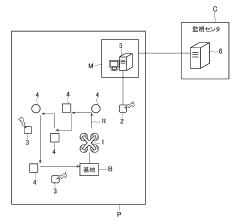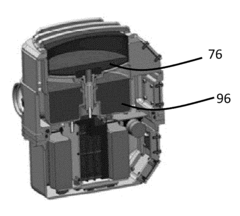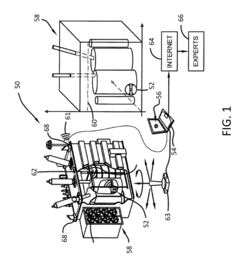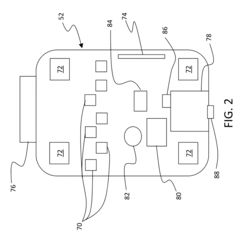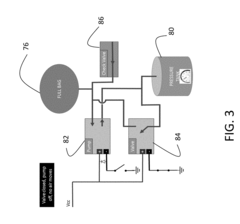Employing drones for real-time submersible pump diagnostics.
JUL 15, 20259 MIN READ
Generate Your Research Report Instantly with AI Agent
Patsnap Eureka helps you evaluate technical feasibility & market potential.
Drone-Pump Diagnostics: Background and Objectives
The integration of drone technology with submersible pump diagnostics represents a significant advancement in the field of water management and industrial maintenance. This innovative approach combines the versatility of unmanned aerial vehicles (UAVs) with the critical need for real-time monitoring and assessment of submersible pumps, which are essential components in various sectors including agriculture, mining, and municipal water systems.
Historically, the inspection and maintenance of submersible pumps have been challenging due to their underwater location and the often harsh environments in which they operate. Traditional methods typically involved shutting down operations, draining water bodies, and physically accessing the pumps, which was time-consuming, costly, and potentially hazardous. The evolution of pump diagnostics has seen a gradual shift from reactive maintenance to preventive strategies, but the introduction of drones marks a leap towards predictive and real-time monitoring capabilities.
The technological trajectory in this domain has been shaped by advancements in several key areas. Drone technology itself has rapidly evolved, with improvements in flight stability, payload capacity, and autonomous navigation. Concurrently, sensor technology has become more sophisticated, miniaturized, and capable of operating in aquatic environments. The convergence of these technologies, along with progress in data transmission and analysis, has paved the way for the current state of drone-based pump diagnostics.
The primary objective of employing drones for real-time submersible pump diagnostics is to enhance the efficiency, safety, and reliability of pump operations. This approach aims to provide continuous monitoring without the need for pump shutdown or human divers, thereby reducing operational downtime and associated costs. Additionally, it seeks to improve the accuracy and timeliness of diagnostic data, enabling predictive maintenance strategies and extending the lifespan of pump equipment.
Another crucial goal is to minimize environmental impact by allowing for non-invasive inspections of underwater infrastructure. This is particularly important in sensitive ecosystems or in applications where water quality is paramount. The technology also aims to enhance worker safety by reducing the need for personnel to enter hazardous environments for routine inspections.
Looking forward, the development of this technology is expected to focus on improving the autonomy and intelligence of drone systems, enhancing their ability to operate in diverse and challenging underwater conditions. There is also a push towards developing more sophisticated sensors and imaging technologies that can provide detailed insights into pump performance and potential failure modes. The integration of artificial intelligence and machine learning algorithms for real-time data analysis and predictive diagnostics represents another frontier in this field.
Historically, the inspection and maintenance of submersible pumps have been challenging due to their underwater location and the often harsh environments in which they operate. Traditional methods typically involved shutting down operations, draining water bodies, and physically accessing the pumps, which was time-consuming, costly, and potentially hazardous. The evolution of pump diagnostics has seen a gradual shift from reactive maintenance to preventive strategies, but the introduction of drones marks a leap towards predictive and real-time monitoring capabilities.
The technological trajectory in this domain has been shaped by advancements in several key areas. Drone technology itself has rapidly evolved, with improvements in flight stability, payload capacity, and autonomous navigation. Concurrently, sensor technology has become more sophisticated, miniaturized, and capable of operating in aquatic environments. The convergence of these technologies, along with progress in data transmission and analysis, has paved the way for the current state of drone-based pump diagnostics.
The primary objective of employing drones for real-time submersible pump diagnostics is to enhance the efficiency, safety, and reliability of pump operations. This approach aims to provide continuous monitoring without the need for pump shutdown or human divers, thereby reducing operational downtime and associated costs. Additionally, it seeks to improve the accuracy and timeliness of diagnostic data, enabling predictive maintenance strategies and extending the lifespan of pump equipment.
Another crucial goal is to minimize environmental impact by allowing for non-invasive inspections of underwater infrastructure. This is particularly important in sensitive ecosystems or in applications where water quality is paramount. The technology also aims to enhance worker safety by reducing the need for personnel to enter hazardous environments for routine inspections.
Looking forward, the development of this technology is expected to focus on improving the autonomy and intelligence of drone systems, enhancing their ability to operate in diverse and challenging underwater conditions. There is also a push towards developing more sophisticated sensors and imaging technologies that can provide detailed insights into pump performance and potential failure modes. The integration of artificial intelligence and machine learning algorithms for real-time data analysis and predictive diagnostics represents another frontier in this field.
Market Analysis for Drone-Based Pump Monitoring
The market for drone-based pump monitoring solutions is experiencing significant growth, driven by the increasing demand for efficient and cost-effective maintenance strategies in various industries. The global submersible pump market, valued at $11.68 billion in 2021, is projected to reach $19.22 billion by 2030, with a compound annual growth rate (CAGR) of 5.7%. This growth is largely attributed to the rising adoption of advanced monitoring and diagnostic technologies, including drone-based solutions.
The oil and gas industry represents a substantial portion of the market for submersible pump monitoring. With over 1 million active oil and gas wells worldwide, the need for reliable and efficient pump monitoring solutions is paramount. Drone-based diagnostics offer a compelling value proposition in this sector, as they can significantly reduce downtime and maintenance costs while improving safety for personnel.
The water and wastewater treatment industry is another key market segment for drone-based pump monitoring. As urbanization continues to accelerate globally, the demand for efficient water management systems is increasing. The global water and wastewater treatment market is expected to reach $211.3 billion by 2025, with submersible pumps playing a crucial role in these systems. Drone-based monitoring solutions can help optimize pump performance and reduce operational costs in this rapidly growing sector.
Mining and construction industries also present significant opportunities for drone-based pump monitoring. These sectors often operate in challenging environments where traditional monitoring methods may be difficult or dangerous. The global mining equipment market, valued at $144.37 billion in 2019, is projected to reach $186.01 billion by 2027, with pumps being an essential component of mining operations.
The agriculture sector is emerging as a promising market for drone-based pump monitoring, particularly in regions facing water scarcity. With the global smart irrigation market expected to grow from $1.5 billion in 2020 to $2.9 billion by 2025, there is a growing need for efficient pump monitoring solutions to optimize water usage and reduce energy consumption.
Geographically, North America and Europe currently lead the market for drone-based pump monitoring solutions, owing to their advanced industrial infrastructure and early adoption of innovative technologies. However, the Asia-Pacific region is expected to witness the highest growth rate in the coming years, driven by rapid industrialization, urbanization, and increasing investments in water management and oil and gas exploration.
The oil and gas industry represents a substantial portion of the market for submersible pump monitoring. With over 1 million active oil and gas wells worldwide, the need for reliable and efficient pump monitoring solutions is paramount. Drone-based diagnostics offer a compelling value proposition in this sector, as they can significantly reduce downtime and maintenance costs while improving safety for personnel.
The water and wastewater treatment industry is another key market segment for drone-based pump monitoring. As urbanization continues to accelerate globally, the demand for efficient water management systems is increasing. The global water and wastewater treatment market is expected to reach $211.3 billion by 2025, with submersible pumps playing a crucial role in these systems. Drone-based monitoring solutions can help optimize pump performance and reduce operational costs in this rapidly growing sector.
Mining and construction industries also present significant opportunities for drone-based pump monitoring. These sectors often operate in challenging environments where traditional monitoring methods may be difficult or dangerous. The global mining equipment market, valued at $144.37 billion in 2019, is projected to reach $186.01 billion by 2027, with pumps being an essential component of mining operations.
The agriculture sector is emerging as a promising market for drone-based pump monitoring, particularly in regions facing water scarcity. With the global smart irrigation market expected to grow from $1.5 billion in 2020 to $2.9 billion by 2025, there is a growing need for efficient pump monitoring solutions to optimize water usage and reduce energy consumption.
Geographically, North America and Europe currently lead the market for drone-based pump monitoring solutions, owing to their advanced industrial infrastructure and early adoption of innovative technologies. However, the Asia-Pacific region is expected to witness the highest growth rate in the coming years, driven by rapid industrialization, urbanization, and increasing investments in water management and oil and gas exploration.
Current Challenges in Submersible Pump Diagnostics
Submersible pump diagnostics currently face several significant challenges that hinder efficient maintenance and operation. One of the primary issues is the difficulty in accessing pumps installed in deep wells or underwater environments. Traditional diagnostic methods often require pump retrieval, leading to costly downtime and potential damage during extraction.
Real-time monitoring of pump performance is another major challenge. Many existing systems rely on periodic inspections or surface-level indicators, which may not provide accurate or timely information about the pump's condition. This lack of continuous data can result in delayed detection of problems, potentially leading to catastrophic failures and extended periods of inoperability.
The harsh operating environments of submersible pumps pose additional diagnostic challenges. Extreme temperatures, high pressures, and corrosive substances can rapidly degrade sensors and monitoring equipment, making it difficult to maintain reliable long-term diagnostics. Furthermore, the presence of abrasive particles in pumped fluids can accelerate wear and tear, complicating the accurate assessment of pump health.
Another significant hurdle is the interpretation of diagnostic data. Submersible pumps often generate complex vibration patterns and performance metrics that require specialized expertise to analyze effectively. The shortage of skilled technicians capable of interpreting this data can lead to misdiagnosis or overlooked issues.
Power supply to diagnostic equipment is also a persistent challenge, especially for pumps located in remote areas or offshore installations. Ensuring a stable and continuous power source for monitoring devices can be problematic, limiting the deployment of advanced diagnostic solutions.
The integration of diagnostic systems with existing pump infrastructure presents another obstacle. Many older pump installations lack the necessary ports or interfaces for modern diagnostic equipment, making retrofitting a complex and expensive process. This compatibility issue often forces operators to choose between costly upgrades or continued reliance on outdated monitoring methods.
Data transmission from submerged pumps to surface-level analysis systems remains a significant technical challenge. Traditional wired connections are prone to damage in harsh environments, while wireless solutions must overcome signal attenuation through water or dense geological formations.
Lastly, the cost-effectiveness of advanced diagnostic systems is a major consideration for many operators. The high initial investment required for sophisticated monitoring equipment can be a deterrent, especially for smaller operations or in cases where pump replacement might be seen as a more economical option than implementing extensive diagnostic capabilities.
Real-time monitoring of pump performance is another major challenge. Many existing systems rely on periodic inspections or surface-level indicators, which may not provide accurate or timely information about the pump's condition. This lack of continuous data can result in delayed detection of problems, potentially leading to catastrophic failures and extended periods of inoperability.
The harsh operating environments of submersible pumps pose additional diagnostic challenges. Extreme temperatures, high pressures, and corrosive substances can rapidly degrade sensors and monitoring equipment, making it difficult to maintain reliable long-term diagnostics. Furthermore, the presence of abrasive particles in pumped fluids can accelerate wear and tear, complicating the accurate assessment of pump health.
Another significant hurdle is the interpretation of diagnostic data. Submersible pumps often generate complex vibration patterns and performance metrics that require specialized expertise to analyze effectively. The shortage of skilled technicians capable of interpreting this data can lead to misdiagnosis or overlooked issues.
Power supply to diagnostic equipment is also a persistent challenge, especially for pumps located in remote areas or offshore installations. Ensuring a stable and continuous power source for monitoring devices can be problematic, limiting the deployment of advanced diagnostic solutions.
The integration of diagnostic systems with existing pump infrastructure presents another obstacle. Many older pump installations lack the necessary ports or interfaces for modern diagnostic equipment, making retrofitting a complex and expensive process. This compatibility issue often forces operators to choose between costly upgrades or continued reliance on outdated monitoring methods.
Data transmission from submerged pumps to surface-level analysis systems remains a significant technical challenge. Traditional wired connections are prone to damage in harsh environments, while wireless solutions must overcome signal attenuation through water or dense geological formations.
Lastly, the cost-effectiveness of advanced diagnostic systems is a major consideration for many operators. The high initial investment required for sophisticated monitoring equipment can be a deterrent, especially for smaller operations or in cases where pump replacement might be seen as a more economical option than implementing extensive diagnostic capabilities.
Existing Drone-Based Pump Diagnostic Solutions
01 Drone-based real-time health monitoring systems
Drones equipped with advanced sensors and diagnostic tools can provide real-time health monitoring for individuals. These systems can collect vital signs, perform quick medical tests, and transmit data to healthcare professionals for immediate analysis and response. This technology is particularly useful in remote or emergency situations where traditional medical facilities are not readily accessible.- Real-time drone-based health monitoring systems: Drones equipped with advanced sensors and diagnostic tools can provide real-time health monitoring for patients. These systems can collect vital signs, perform quick medical tests, and transmit data to healthcare professionals for immediate analysis and response. This technology is particularly useful in remote or emergency situations where traditional medical facilities are not readily accessible.
- Drone-assisted environmental and agricultural diagnostics: Drones can be utilized for real-time diagnostics in environmental monitoring and agriculture. They can assess crop health, detect pests or diseases, monitor soil conditions, and analyze air and water quality. This allows for rapid identification of issues and implementation of targeted interventions, improving overall agricultural productivity and environmental management.
- Autonomous drone swarms for large-scale diagnostics: Swarms of autonomous drones can be deployed for large-scale diagnostic operations. These coordinated groups of drones can cover vast areas quickly, performing simultaneous diagnostics on infrastructure, natural disasters, or public health emergencies. The collective data from the swarm provides a comprehensive real-time assessment of the situation.
- AI-powered drone diagnostics and decision-making: Artificial intelligence integrated into drone systems enhances real-time diagnostic capabilities. AI algorithms can process and analyze data collected by drones on the fly, enabling immediate decision-making and adaptive responses. This technology is particularly useful in complex diagnostic scenarios that require rapid interpretation of multiple data points.
- Drone-based telemedicine and remote diagnostics: Drones equipped with telemedicine capabilities can facilitate remote diagnostics and medical consultations. These systems can transport medical equipment, conduct virtual examinations, and enable real-time communication between patients and healthcare providers. This technology extends medical care to underserved areas and provides rapid response in emergency situations.
02 Aerial imaging and analysis for infrastructure inspection
Drones equipped with high-resolution cameras and specialized sensors can perform real-time diagnostics on infrastructure such as buildings, bridges, and power lines. These systems can detect structural defects, assess damage, and identify potential hazards, allowing for timely maintenance and repairs. The data collected can be analyzed in real-time or transmitted to experts for further evaluation.Expand Specific Solutions03 Agricultural drone diagnostics for crop health
Drones equipped with multispectral cameras and other sensors can provide real-time diagnostics of crop health. These systems can detect plant diseases, pest infestations, nutrient deficiencies, and water stress. The data collected allows farmers to make informed decisions about irrigation, fertilization, and pest control, optimizing crop yield and reducing resource waste.Expand Specific Solutions04 Environmental monitoring and pollution detection
Drones equipped with specialized sensors can perform real-time diagnostics of air and water quality. These systems can detect pollutants, measure particulate matter, and analyze chemical compositions in the atmosphere or water bodies. This technology is valuable for environmental monitoring, disaster response, and ensuring public safety in industrial areas.Expand Specific Solutions05 Autonomous drone swarms for large-scale diagnostics
Swarms of autonomous drones can work together to perform large-scale, real-time diagnostics across vast areas. These systems can coordinate their movements, share data, and collectively analyze complex environments. Applications include search and rescue operations, disaster assessment, and monitoring of large industrial facilities or urban areas.Expand Specific Solutions
Key Players in Drone and Pump Diagnostic Industries
The market for employing drones in real-time submersible pump diagnostics is in its early growth stage, with increasing adoption across industries. The global market size for this technology is expanding, driven by the need for efficient and cost-effective pump monitoring solutions. While the technology is still evolving, several key players are making significant strides in its development and implementation. Companies like Schlumberger, ShinMaywa Industries, and Hitachi Energy are at the forefront, leveraging their expertise in oilfield services, industrial machinery, and energy systems to advance drone-based diagnostics. Other notable contributors include Textron Systems and Sensia LLC, who are bringing their automation and unmanned systems capabilities to this emerging field. As the technology matures, we can expect increased competition and innovation from both established players and new entrants.
Schlumberger Canada Ltd.
Technical Solution: Schlumberger has developed an advanced drone-based system for real-time submersible pump diagnostics. The system utilizes high-resolution cameras and sensors mounted on drones to capture detailed imagery and data of submersible pumps in operation. Machine learning algorithms process this data in real-time, identifying potential issues such as wear, corrosion, or performance anomalies. The drones are equipped with specialized sonar and acoustic sensors to operate effectively underwater, providing a comprehensive view of the pump's condition without the need for manual inspection or shutdown[1][3]. This technology integrates with Schlumberger's existing digital oilfield solutions, allowing for seamless data integration and analysis across the entire production system.
Strengths: Comprehensive real-time diagnostics, reduced downtime, improved safety by minimizing human intervention. Weaknesses: High initial investment, potential regulatory challenges in some regions, reliance on stable connectivity for real-time data transmission.
ShinMaywa Industries, Ltd.
Technical Solution: ShinMaywa Industries has developed a drone-based submersible pump diagnostic system that combines aerial and underwater capabilities. Their drones are equipped with both aerial and submersible functionalities, allowing for seamless transition between above-water and underwater operations. The system uses advanced sonar technology and high-definition cameras to capture detailed images and data of submersible pumps. Real-time data processing is achieved through edge computing capabilities integrated into the drone itself, reducing latency in diagnostics[2]. The drones are also equipped with robotic arms for minor interventions and sample collection, enhancing the diagnostic capabilities beyond mere observation[4].
Strengths: Versatile aerial and underwater operation, on-board processing for faster diagnostics, capability for minor interventions. Weaknesses: Complex design may lead to higher maintenance requirements, limited operation time due to power constraints in dual-mode operation.
Core Innovations in Real-Time Pump Monitoring
Unmanned mobile unit and patrolling check system
PatentWO2019176710A1
Innovation
- An unmanned mobile unit, such as a drone, autonomously patrols and inspects water treatment sites, acquiring and wirelessly transmitting data including image, audio, and gas detection data, allowing for frequent and cost-effective monitoring of equipment without the need for expensive online instruments.
Submersible drone having active ballast system
PatentActiveUS20180154995A1
Innovation
- A submersible ROV equipped with a ballast system comprising a flexible ballast bag, pressure vessel, pump, valve, and check valve, which allows for wireless control of air flow to manage buoyancy and prevent air leakage by inflating or deflating the ballast bag, and using a recirculating air system to maintain stability and control within the transformer tank.
Regulatory Framework for Drone Operations in Industry
The regulatory framework for drone operations in industry is a critical aspect of employing drones for real-time submersible pump diagnostics. As this technology gains traction, governments and regulatory bodies worldwide are developing and refining guidelines to ensure safe and responsible drone use in industrial settings.
In the United States, the Federal Aviation Administration (FAA) has established comprehensive regulations for commercial drone operations under Part 107 of the Federal Aviation Regulations. These rules cover various aspects, including pilot certification, drone registration, and operational limitations. For industrial applications like submersible pump diagnostics, operators must obtain a Remote Pilot Certificate and adhere to specific flight restrictions, such as maintaining visual line of sight and flying below 400 feet above ground level.
The European Union Aviation Safety Agency (EASA) has implemented a risk-based approach to drone regulations, categorizing operations into three classes: open, specific, and certified. Industrial drone operations for pump diagnostics would likely fall under the "specific" category, requiring a risk assessment and operational authorization from the national aviation authority.
In addition to aviation regulations, industrial drone operations must comply with privacy and data protection laws. The General Data Protection Regulation (GDPR) in the EU and similar laws in other jurisdictions impose strict requirements on the collection, processing, and storage of data captured by drones during diagnostic operations.
Safety regulations also play a crucial role in the regulatory framework. Many countries require operators to develop and follow safety management systems, conduct risk assessments, and implement mitigation measures to ensure the safety of personnel and equipment during drone operations in industrial environments.
Environmental regulations may also apply, particularly when operating drones near water bodies for submersible pump diagnostics. Operators must be aware of and comply with local environmental protection laws to minimize the impact on aquatic ecosystems.
As the technology evolves, regulatory frameworks are expected to adapt. Many countries are exploring performance-based regulations that focus on the desired outcomes rather than prescriptive rules. This approach may provide more flexibility for innovative applications like real-time submersible pump diagnostics.
Internationally, efforts are underway to harmonize drone regulations across borders. Organizations like the International Civil Aviation Organization (ICAO) are working to develop global standards for drone operations, which could facilitate the adoption of drone-based diagnostic technologies in multinational industrial settings.
In the United States, the Federal Aviation Administration (FAA) has established comprehensive regulations for commercial drone operations under Part 107 of the Federal Aviation Regulations. These rules cover various aspects, including pilot certification, drone registration, and operational limitations. For industrial applications like submersible pump diagnostics, operators must obtain a Remote Pilot Certificate and adhere to specific flight restrictions, such as maintaining visual line of sight and flying below 400 feet above ground level.
The European Union Aviation Safety Agency (EASA) has implemented a risk-based approach to drone regulations, categorizing operations into three classes: open, specific, and certified. Industrial drone operations for pump diagnostics would likely fall under the "specific" category, requiring a risk assessment and operational authorization from the national aviation authority.
In addition to aviation regulations, industrial drone operations must comply with privacy and data protection laws. The General Data Protection Regulation (GDPR) in the EU and similar laws in other jurisdictions impose strict requirements on the collection, processing, and storage of data captured by drones during diagnostic operations.
Safety regulations also play a crucial role in the regulatory framework. Many countries require operators to develop and follow safety management systems, conduct risk assessments, and implement mitigation measures to ensure the safety of personnel and equipment during drone operations in industrial environments.
Environmental regulations may also apply, particularly when operating drones near water bodies for submersible pump diagnostics. Operators must be aware of and comply with local environmental protection laws to minimize the impact on aquatic ecosystems.
As the technology evolves, regulatory frameworks are expected to adapt. Many countries are exploring performance-based regulations that focus on the desired outcomes rather than prescriptive rules. This approach may provide more flexibility for innovative applications like real-time submersible pump diagnostics.
Internationally, efforts are underway to harmonize drone regulations across borders. Organizations like the International Civil Aviation Organization (ICAO) are working to develop global standards for drone operations, which could facilitate the adoption of drone-based diagnostic technologies in multinational industrial settings.
Environmental Impact of Drone-Based Pump Diagnostics
The implementation of drone-based real-time submersible pump diagnostics brings both positive and negative environmental impacts that warrant careful consideration. On the positive side, this technology can significantly reduce the need for manual inspections, thereby minimizing human disturbance to aquatic ecosystems. Drones can access remote or hazardous locations with ease, allowing for more frequent and comprehensive monitoring without causing physical disruption to the surrounding environment.
Furthermore, the use of drones for pump diagnostics can lead to early detection of malfunctions or inefficiencies, potentially preventing catastrophic failures that could result in environmental contamination. By enabling proactive maintenance, this technology helps maintain optimal pump performance, reducing energy consumption and associated carbon emissions. The improved efficiency in pump operations can also contribute to better water management practices, particularly in regions facing water scarcity issues.
However, the environmental impact of drone operations themselves must be taken into account. The noise generated by drones, especially when operating at low altitudes, can disturb wildlife, particularly in sensitive aquatic habitats. This acoustic pollution may affect the behavior and communication patterns of various species, potentially disrupting local ecosystems. Additionally, the visual presence of drones may cause stress to animals, altering their natural behaviors and potentially impacting breeding patterns or feeding habits.
There are also concerns regarding the potential for drone crashes or malfunctions, which could lead to pollution if drones end up in water bodies. The materials used in drone construction, including batteries and electronic components, may pose environmental risks if not properly managed or recovered. Moreover, the increased use of drones for pump diagnostics may lead to a proliferation of drone activities in natural areas, potentially contributing to habitat fragmentation and wildlife disturbance on a broader scale.
To mitigate these negative impacts, it is crucial to develop and adhere to strict operational guidelines for drone-based pump diagnostics. These should include measures to minimize noise pollution, such as using quieter drone models or operating at higher altitudes when possible. Implementing no-fly zones in particularly sensitive areas and scheduling drone operations to avoid critical wildlife periods can help reduce disturbance to local fauna. Additionally, investing in biodegradable or environmentally friendly drone materials and establishing robust recovery protocols for crashed drones can minimize the risk of environmental contamination.
In conclusion, while drone-based submersible pump diagnostics offer significant environmental benefits through improved efficiency and reduced human intervention, the potential negative impacts on ecosystems must be carefully managed. Striking a balance between technological advancement and environmental preservation will be key to ensuring the sustainable implementation of this innovative approach to pump maintenance and monitoring.
Furthermore, the use of drones for pump diagnostics can lead to early detection of malfunctions or inefficiencies, potentially preventing catastrophic failures that could result in environmental contamination. By enabling proactive maintenance, this technology helps maintain optimal pump performance, reducing energy consumption and associated carbon emissions. The improved efficiency in pump operations can also contribute to better water management practices, particularly in regions facing water scarcity issues.
However, the environmental impact of drone operations themselves must be taken into account. The noise generated by drones, especially when operating at low altitudes, can disturb wildlife, particularly in sensitive aquatic habitats. This acoustic pollution may affect the behavior and communication patterns of various species, potentially disrupting local ecosystems. Additionally, the visual presence of drones may cause stress to animals, altering their natural behaviors and potentially impacting breeding patterns or feeding habits.
There are also concerns regarding the potential for drone crashes or malfunctions, which could lead to pollution if drones end up in water bodies. The materials used in drone construction, including batteries and electronic components, may pose environmental risks if not properly managed or recovered. Moreover, the increased use of drones for pump diagnostics may lead to a proliferation of drone activities in natural areas, potentially contributing to habitat fragmentation and wildlife disturbance on a broader scale.
To mitigate these negative impacts, it is crucial to develop and adhere to strict operational guidelines for drone-based pump diagnostics. These should include measures to minimize noise pollution, such as using quieter drone models or operating at higher altitudes when possible. Implementing no-fly zones in particularly sensitive areas and scheduling drone operations to avoid critical wildlife periods can help reduce disturbance to local fauna. Additionally, investing in biodegradable or environmentally friendly drone materials and establishing robust recovery protocols for crashed drones can minimize the risk of environmental contamination.
In conclusion, while drone-based submersible pump diagnostics offer significant environmental benefits through improved efficiency and reduced human intervention, the potential negative impacts on ecosystems must be carefully managed. Striking a balance between technological advancement and environmental preservation will be key to ensuring the sustainable implementation of this innovative approach to pump maintenance and monitoring.
Unlock deeper insights with Patsnap Eureka Quick Research — get a full tech report to explore trends and direct your research. Try now!
Generate Your Research Report Instantly with AI Agent
Supercharge your innovation with Patsnap Eureka AI Agent Platform!



